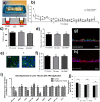Microfluidic-Based Multi-Organ Platforms for Drug Discovery
- PMID: 30404334
- PMCID: PMC6189912
- DOI: 10.3390/mi7090162
Microfluidic-Based Multi-Organ Platforms for Drug Discovery
Abstract
Development of predictive multi-organ models before implementing costly clinical trials is central for screening the toxicity, efficacy, and side effects of new therapeutic agents. Despite significant efforts that have been recently made to develop biomimetic in vitro tissue models, the clinical application of such platforms is still far from reality. Recent advances in physiologically-based pharmacokinetic and pharmacodynamic (PBPK-PD) modeling, micro- and nanotechnology, and in silico modeling have enabled single- and multi-organ platforms for investigation of new chemical agents and tissue-tissue interactions. This review provides an overview of the principles of designing microfluidic-based organ-on-chip models for drug testing and highlights current state-of-the-art in developing predictive multi-organ models for studying the cross-talk of interconnected organs. We further discuss the challenges associated with establishing a predictive body-on-chip (BOC) model such as the scaling, cell types, the common medium, and principles of the study design for characterizing the interaction of drugs with multiple targets.
Keywords: body-on-chip; drug discovery; in silico modeling; microfluidics; organ-on-chip.
Conflict of interest statement
The authors declare no conflict of interest.
Figures




Similar articles
-
Human-on-a-chip design strategies and principles for physiologically based pharmacokinetics/pharmacodynamics modeling.Integr Biol (Camb). 2015 Apr;7(4):383-91. doi: 10.1039/c4ib00292j. Integr Biol (Camb). 2015. PMID: 25739725 Free PMC article. Review.
-
Microengineered Organ-on-a-chip Platforms towards Personalized Medicine.Curr Pharm Des. 2018;24(45):5354-5366. doi: 10.2174/1381612825666190222143542. Curr Pharm Des. 2018. PMID: 30799783 Review.
-
Organ-on-a-chip technology and microfluidic whole-body models for pharmacokinetic drug toxicity screening.Biotechnol J. 2013 Nov;8(11):1258-66. doi: 10.1002/biot.201300086. Epub 2013 Aug 23. Biotechnol J. 2013. PMID: 24038956 Review.
-
Organ/body-on-a-chip based on microfluidic technology for drug discovery.Drug Metab Pharmacokinet. 2018 Feb;33(1):43-48. doi: 10.1016/j.dmpk.2017.11.003. Epub 2017 Nov 13. Drug Metab Pharmacokinet. 2018. PMID: 29175062 Review.
-
Microfluidic 'brain-on chip' systems to supplement neurological practice: development, applications and considerations.Regen Med. 2023 May;18(5):413-423. doi: 10.2217/rme-2022-0212. Epub 2023 Apr 26. Regen Med. 2023. PMID: 37125510 Review.
Cited by
-
Multi-Organs-on-Chips for Testing Small-Molecule Drugs: Challenges and Perspectives.Pharmaceutics. 2021 Oct 11;13(10):1657. doi: 10.3390/pharmaceutics13101657. Pharmaceutics. 2021. PMID: 34683950 Free PMC article. Review.
-
3D engineered tissue models for studying human-specific infectious viral diseases.Bioact Mater. 2022 Sep 22;21:576-594. doi: 10.1016/j.bioactmat.2022.09.010. eCollection 2023 Mar. Bioact Mater. 2022. PMID: 36204281 Free PMC article. Review.
-
Evolution of Biochip Technology: A Review from Lab-on-a-Chip to Organ-on-a-Chip.Micromachines (Basel). 2020 Jun 18;11(6):599. doi: 10.3390/mi11060599. Micromachines (Basel). 2020. PMID: 32570945 Free PMC article. Review.
-
Recent advances in microfluidics for drug screening.Biomicrofluidics. 2019 Nov 18;13(6):061503. doi: 10.1063/1.5121200. eCollection 2019 Nov. Biomicrofluidics. 2019. PMID: 31768197 Free PMC article. Review.
-
Synthetic Biology Approaches in The Development of Engineered Therapeutic Microbes.Int J Mol Sci. 2020 Nov 19;21(22):8744. doi: 10.3390/ijms21228744. Int J Mol Sci. 2020. PMID: 33228099 Free PMC article. Review.
References
Publication types
LinkOut - more resources
Full Text Sources
Other Literature Sources

